Medium-Voltage DC-DC Converter Topologies for Electric Bus Fast Charging Stations: State-of-the-Art Review
Abstract
:1. Introduction
2. Basic Isolated and Non-Isolated DC-DC Converter Topologies
3. DC-DC Converters for Medium Voltage E-Bus Charging
3.1. Single-Stage DC-DC Converters
3.1.1. Modular Multilevel DC-DC Converter (MMC)
3.1.2. MVDC Auto-Transformer (MVDC-AT)
3.1.3. Hybrid Cascaded DC-DC Converter (HCDC)
3.2. Two-Stage DC-DC Converters
3.2.1. MMC-Based LCL DC-DC Converter
3.2.2. Two-Level Dual Active Bridge Converter (2L-DAB)
3.2.3. Multimodule DC-DC Converters (MCs)
3.2.4. Modular Multilevel Converter (MMC-DAB/ MMC-F2F)
- The use of multiple low-voltage SMs enabled the converter to be fully modular and scalable, where connecting SMs in series can achieve different voltage and power levels.
- In addition, the multilevel architecture allowed for low total harmonic distortion in the AC waveform output, which will significantly reduce the AC side filtering requirement.
- Low electromagnetic interference is achieved because of the low rate of change of voltage and the enhanced reliability introduced by the redundant SMs.
- A.
- Conventional Multilevel operation of MMC-DAB
- B.
- Quasi-two-level (Q2L) operation of MMC-DAB
- C.
- MMC Topologies Assessment
4. Medium-Voltage DC-DC Converters Challenges and Requirements
- Harmonic Currents: The existence of voltage and current oscillations in such systems makes the harmonics discussion relevant in which the term harmonics refers to the oscillatory voltages and currents. Due to the non-linear effects of power converters, harmonic currents, and circulating currents result. To limit the harmonic currents, filters are required. Voltage oscillations and resonance currents can result from harmonic currents, which may reflect voltage harmonic distortion at the point of common coupling (PCC) of the AC grid. In this regard, utility customers are limited by the harmonic current requirements in international standards (e.g., IEEE 519) [64].
- Inrush current: To control the harmonic currents and voltage ripple resulting from the load and the source converter, respectively, filters are utilized in which the filter capacitance may cause inrush currents. To solve the inrush current problem, soft-start techniques are addressed in [65].
- Fault Current: Due to the absence of periodic voltage and zero current crossings, arcing faults cannot be detected and extinguished easily in DC systems. Additionally, fault current contribution represents an issue in DC networks. Therefore, a DC-DC converter with fault current blocking capability is required. In this regard, protection in DC systems is of high interest. A review focusing on DC protection is carried out and conducted in [66].
- Grounding: The selection of the grounding configuration in the DC systems affects the power quality as well as the safety of the overall system, especially in fault conditions. In this regard, the European Telecommunications Standards Institute (ETSI) published a standard document that provides details about grounding techniques for data centers [67].
5. Conclusions
Author Contributions
Funding
Institutional Review Board Statement
Informed Consent Statement
Data Availability Statement
Acknowledgments
Conflicts of Interest
References
- Electric Buses and Charging Infrastructures in the World-Ies-Synergy. IES. 5 March 2021. Available online: https://www.ies-synergy.com/en/electric-buses-where-are-we/ (accessed on 1 January 2022).
- Paddon, T.; Welch, D.; Silver, F. California Transit Agencies Chart a Course to Zero Emissions: A Review of Proposed Zeb Pathways under the Innovative Clean Transit Regulation; Calstart: Pasadena, CA, USA, 2021; Report; pp. 1–18. [Google Scholar]
- Staff, E. A Third of European Public Transport Buses to Be Zero Emission by 2030, with over 10,000 ZE Registrations Yearly beyond 2025. Sustainable Bus. 15 December 2021. Available online: https://www.sustainable-bus.com/news/electric-bus-market-ing-europe-forecast/ (accessed on 1 January 2022).
- Lucintel. Opportunities and Competitive Analysis of the Electric BUS Market; Lucintel: Dallas, TX, USA, 2021; Report. [Google Scholar]
- Mathieu, L. Electric-Buses Arrive on Time Marketplace, Economic, Technology, Environmental and Policy Perspectives for Fully Electric Buses in the EU; Transport and Environment: Brussels, Belgium, 2018. [Google Scholar]
- Electric Bus Market Research Report: By Vehicle (Battery Electric Bus, Plug-in Hybrid Electric Bus, Hybrid Electric Bus, Length (More than 10 m, Less than 10 m), Battery (Lithium–Iron–Phosphate, Lithium–Nickel–Manganese–Cobalt Oxide), End User (Public, Private)—Global Industry Analysis and Growth Forecast to 2026; Prescient & Strategic Intelligence: Delhi, India, 2021; Report; pp. 1–450.
- Jiang, M.; Zhang, Y.; Zhang, Y. Multi-Depot Electric Bus Scheduling Considering Operational Constraint and Partial Charging: A Case Study in Shenzhen, China. Sustainability 2022, 14, 255. [Google Scholar] [CrossRef]
- Al-Ogaili, A.S.; Al-Shetwi, A.Q.; Sudhakar Babu, T.; Hoon, Y.; Abdullah, M.A.; Alhasan, A.; Al-Sharaa, A. Electric Buses in Malaysia: Policies, Innovations, Technologies and Life Cycle Evaluations. Sustainability 2021, 13, 11577. [Google Scholar] [CrossRef]
- Barraza, O.; Estrada, M. Battery Electric Bus Network: Efficient Design and Cost Comparison of Different Powertrains. Sustainability 2021, 13, 4745. [Google Scholar] [CrossRef]
- Verbrugge, B.; Hasan, M.M.; Rasool, H.; Geury, T.; El Baghdadi, M.; Hegazy, O. Smart Integration of Electric Buses in Cities: A Technological Review. Sustainability 2021, 13, 12189. [Google Scholar] [CrossRef]
- Ding, X.; Zhang, W.; Wei, S.; Wang, Z. Optimization of an Energy Storage System for Electric Bus Fast-Charging Station. Energies 2021, 14, 4143. [Google Scholar] [CrossRef]
- Arif, S.M.; Lie, T.T.; Seet, B.C.; Ahsan, S.M.; Khan, H.A. Plug-In Electric Bus Depot Charging with PV and ESS and Their Impact on LV Feeder. Energies 2020, 13, 2139. [Google Scholar] [CrossRef]
- Zagrajek, K.; Paska, J.; Kłos, M.; Pawlak, K.; Marchel, P.; Bartecka, M.; Michalski, Ł.; Terlikowski, P. Impact of Electric Bus Charging on Distribution Substation and Local Grid in Warsaw. Energies 2020, 13, 1210. [Google Scholar] [CrossRef] [Green Version]
- Song, Z.; Liu, Y.; Gao, H.; Li, S. The Underlying Reasons behind the Development of Public Electric Buses in China: The Beijing Case. Sustainability 2020, 12, 688. [Google Scholar] [CrossRef] [Green Version]
- Qin, W.; Wang, L.; Liu, Y.; Xu, C. Energy Consumption Estimation of the Electric Bus Based on Grey Wolf Optimization Algorithm and Support Vector Machine Regression. Sustainability 2021, 13, 4689. [Google Scholar] [CrossRef]
- Li, W.; Li, Y.; Deng, H.; Bao, L. Planning of Electric Public Transport System under Battery Swap Mode. Sustainability 2018, 10, 2528. [Google Scholar] [CrossRef] [Green Version]
- Yang, H. Modular and Scalable DC-DC Converters for Medium-/High-Power Applications. Master’s Thesis, Georgia Institute of Technology, Atlanta, GA, USA, 2017. [Google Scholar]
- Wan, H. High Efficiency DC-DC Converter for EV Battery Charger Using Hybrid Resonant and PWM Technique. Master’s Thesis, Virginia Tech, Blacksburg, VA, USA, 2012. [Google Scholar]
- ElMenshawy, M.; Massoud, A. Hybrid multimodule DC-DC converters for Ultrafast Electric Vehicle Chargers. Energies 2020, 13, 4949. [Google Scholar] [CrossRef]
- Beldjajev, V. Research and Development of the New Topologies for the Isolation Stage of the Power Electronic Transformer. Master’s Thesis, Tallinn University Of Technology, Tallinn, Estonia, 2013. [Google Scholar]
- Engel, S.P.; Stieneker, M.; Soltau, N.; Rabiee, S.; Stagge, H.; De Doncker, R.W. Comparison of the Modular Multilevel DC Converter and the Dual-Active Bridge Converter for Power Conversion in HVDC and MVDC Grids. IEEE Trans. Power Electron. 2014, 30, 124–137. [Google Scholar] [CrossRef]
- Sari, H.I. DC/DC Converters for Multi-Terminal HVDC Systems Based on Modular Multilevel Converter. Master’s Thesis, Norwegian University of Science and Technology, Trondheim, Norweg, August 2016. [Google Scholar]
- Papadakis, C. Protection of HVDC Grids Using DC Hub. Master’s Thesis, Delft University of Technology, Delft, The Netherlands, 2017. [Google Scholar]
- Ferreira, J.A. The Multilevel Modular DC Converter. IEEE Trans. Power Electron. 2013, 28, 4460–4465. [Google Scholar] [CrossRef]
- Schön, A.; Bakran, M.M. A new HVDC-DC converter for the efficient connection of HVDC networks. In PCIM Europe Conference Proceedings; PCIM: Nürnberg, Germany, 2013. [Google Scholar]
- Schoen, A.; Bakran, M.M. Comparison of the most efficient DC-DC converters for power conversion in HVDC grids. In Proceedings of the PCIM Europe 2015; International Exhibition and Conference for Power Electronics, Intelligent Motion, Renewable Energy and Energy Management, Nuremberg, Germany, 19–20 May 2015; pp. 1–9. [Google Scholar]
- Schön, A.; Bakran, M.M. Average loss calculation and efficiency of the new HVDC auto transformer. In Proceedings of the 2014 16th European Conference on Power Electronics and Applications, Lappeenranta, Finland, 26–28 August 2014; pp. 1–10. [Google Scholar]
- Yang, J.; He, Z.; Pang, H.; Tang, G. The Hybrid-Cascaded DC–DC Converters Suitable for HVdc Applications. IEEE Trans. Power Electron. 2015, 30, 5358–5363. [Google Scholar] [CrossRef]
- Kish, G.J.; Lehn, P.W. A modular bidirectional DC power flow controller with fault blocking capability for DC networks. In Proceedings of the 2013 IEEE 14th Workshop on Control and Modeling for Power Electronics (COMPEL), Salt Lake City, UT, USA, 23–26 June 2013; pp. 1–7. [Google Scholar]
- Hongcheng, Y.; Cai, X. A family of un-isolated modular DC/DC converters. In Proceedings of the 2016 IEEE 8th International Power Electronics and Motion Control Conference (IPEMC-ECCE Asia), Hefei, China, 22–26 May 2016; pp. 696–702. [Google Scholar]
- Xing, Z.; Ruan, X.; Xie, H.; Wang, X. A modular bidirectional buck/boost dc/dc converter suitable for interconnecting HVDC grids. In Proceedings of the 2016 IEEE 8th International Power Electronics and Motion Control Conference (IPEMC-ECCE Asia), Hefei, China, 22–26 May 2016; pp. 3348–3354. [Google Scholar]
- De Doncker, R.W.A.A.; Divan, D.M.; Kheraluwala, M.H. A three-phase soft-switched high-power-density DC/DC converter for high-power applications. IEEE Trans. Ind. Appl. 1991, 27, 63–73. [Google Scholar] [CrossRef]
- Soltau, N.; Stagge, H.; De Doncker, R.W.; Apeldoorn, O. Development and demonstration of a medium-voltage high-power DC-DC converter for DC distribution systems. In Proceedings of the 2014 IEEE 5th International Symposium on Power Electronics for Distributed Generation Systems (PEDG), Galway, Ireland, 26–29 June 2014; pp. 1–8. [Google Scholar]
- Far, A.J.; Hajian, M.; Jovcic, D.; Audichya, Y. Optimal design of high power MMC-based LCL DC/DC converter. In Proceedings of the 2016 IEEE Power and Energy Society General Meeting (PESGM), Boston, MA, USA, 17–21 July 2016; pp. 1–5. [Google Scholar]
- Jovcic, D. Bidirectional, High-Power DC Transformer. IEEE Trans. Power Deliv. 2009, 24, 2276–2283. [Google Scholar] [CrossRef]
- Jovcic, D.; Zhang, J. High power IGBT-based DC/DC converter with DC fault tolerance. In Proceedings of the 2012 15th International Power Electronics and Motion Control Conference (EPE/PEMC), Novi Sad, Serbia, 4–6 September 2012; pp. DS3b.6-1–DS3b.6-6. [Google Scholar]
- Kheraluwala, M.H.; Gasgoigne, R.W.; Divan, D.M.; Bauman, E. Performance characterization of a high power dual active bridge DC/DC converter. In Proceedings of the Conference Record of the 1990 IEEE Industry Applications Society Annual Meeting, Seattle, WA, USA, 7–12 October 1990; Volume 2, pp. 1267–1273. [Google Scholar]
- Oggier, G.G.; GarcÍa, G.O.; Oliva, A.R. Switching Control Strategy to Minimize Dual Active Bridge Converter Losses. IEEE Trans. Power Electron. 2009, 24, 1826–1838. [Google Scholar] [CrossRef]
- Qin, H. Dual Active Bridge Converters in Solid State Transformers. Master’s Thesis, Missouri University of Science and Technology, Rolla, MO, USA, 2012. [Google Scholar]
- Chen, W. DC/DC Conversion Systems Consisting of Multiple Converter Modules: Stability, Control, and Experimental Verifications. IEEE Trans. Power Electron. 2009, 24, 1463–1474. [Google Scholar] [CrossRef]
- Shi, J.; Luo, J.; He, X. Common-Duty-Ratio Control of Input-Series Output-Parallel Connected Phase-shift Full-Bridge DC-DC Converter Modules. IEEE Trans. Power Electron. 2011, 26, 3318–3329. [Google Scholar] [CrossRef]
- Giri, R. Common-duty-ratio control of input-series connected modular DC-DC converters with active input voltage and load-current sharing. IEEE Trans. Ind. Appl. 2006, 42, 1101–1111. [Google Scholar] [CrossRef]
- Lian, Y.; Adam, G.P.; Holliday, D.; Finney, S.J. Medium-voltage DC/DC converter for offshore wind collection grid. IET Renew. Power Gener. 2016, 10, 651–660. [Google Scholar] [CrossRef]
- Adam, G.P.; Gowaid, I.A.; Finney, S.J.; Holliday, D.; Williams, B.W. Review of dc-dc converters for multi-terminal HVDC transmission networks. IET Power Electron. 2016, 9, 281–296. [Google Scholar] [CrossRef] [Green Version]
- Wu, H.; Lu, Y.; Mu, T.; Xing, Y. A Family of Soft-Switching DC-DC Converters Based on a Phase-Shift-Controlled Active Boost Rectifier. IEEE Trans. Power Electron. 2015, 30, 657–667. [Google Scholar] [CrossRef]
- Inoue, S.; Akagi, H. A bi-directional isolated DC/DC converter as a core circuit of the next-generation medium-voltage power conversion system. In Proceedings of the 2006 37th IEEE Power Electronics Specialists Conference, Jeju, Korea, 18–22 June 2006; pp. 1–7. [Google Scholar]
- ElMenshawy, M.; Massoud, A. Modular isolated DC-DC converters for ultra-fast EV Chargers: A generalized modeling and control approach. Energies 2020, 13, 2540. [Google Scholar] [CrossRef]
- ElMenshawy, M.; Massoud, A. Development of modular DC-DC converters for low-speed electric vehicles fast chargers. Alex. Eng. J. 2020, 60, 1067–1083. [Google Scholar] [CrossRef]
- Carrizosa, M.J.; Benchaib, A.; Alou, P.; Damm, G. DC transformer for DC/DC connection in HVDC network. In Proceedings of the 2013 15th European Conference on Power Electronics and Applications (EPE), Lille, France, 2–6 September 2013; pp. 1–10. [Google Scholar]
- Lesnicar, A.; Marquardt, R. An innovative modular multilevel converter topology suitable for a wide power range. In Proceedings of the 2003 IEEE Bologna Power Tech Conference Proceedings, Bologna, Italy, 23–26 June 2003; Volume 3, p. 6. [Google Scholar]
- Gowaid, I.A.; Adam, G.P.; Ahmed, S.; Holliday, D.; Williams, B.W. Analysis and Design of a Modular Multilevel Converter With Trapezoidal Modulation for Medium and High Voltage DC-DC Transformers. IEEE Trans. Power Electron. 2014, 30, 5439–5457. [Google Scholar] [CrossRef] [Green Version]
- Xing, Z.; Ruan, X.; You, H.; Yang, X.; Yao, D.; Yuan, C. Soft-Switching Operation of Isolated Modular DC/DC Converters for Application in HVDC Grids. IEEE Trans. Power Electron. 2015, 31, 2753–2766. [Google Scholar] [CrossRef]
- Kish, G.J.; Ranjram, M.; Lehn, P.W. A Modular Multilevel DC/DC Converter With Fault Blocking Capability for HVDC Interconnects. IEEE Trans. Power Electron. 2013, 30, 148–162. [Google Scholar] [CrossRef]
- Zhang, Y.; Adam, G.; Finney, S.; Williams, B. Improved pulse-width modulation and capacitor voltage-balancing strategy for a scalable hybrid cascaded multilevel converter. IET Power Electron. 2013, 6, 783–797. [Google Scholar] [CrossRef]
- Kenzelmann, S.; Rufer, A.; Dujic, D.; Canales, F.; de Novaes, Y.R. Isolated DC/DC Structure Based on Modular Multilevel Converter. IEEE Trans. Power Electron. 2014, 30, 89–98. [Google Scholar] [CrossRef]
- Gowaid, I.A.; Adam, G.P.; Massoud, A.M.; Ahmed, S.; Holliday, D.; Williams, B.W. Quasi Two-Level Operation of Modular Multilevel Converter for Use in a High-Power DC Transformer With DC Fault Isolation Capability. IEEE Trans. Power Electron. 2014, 30, 108–123. [Google Scholar] [CrossRef] [Green Version]
- Gowaid, I.A.; Adam, G.P.; Williams, B.W.; Massoud, A.M.; Ahmed, S. The transition arm multilevel converter—A concept for medium and high voltage DC-DC transformers. In Proceedings of the 2015 IEEE International Conference on Industrial Technology (ICIT), Seville, Spain, 17–19 March 2015; pp. 3099–3104. [Google Scholar]
- Schön, A.; Bakran, M.M. Comparison of modular multilevel converter based HV DC-DC-converters. In Proceedings of the 2016 18th European Conference on Power Electronics and Applications (EPE’16 ECCE Europe), Karlsruhe, Germany, 5–9 September 2016; pp. 1–10. [Google Scholar]
- Kusaka, K.; Orikawa, K.; Itoh, J.; Morita, K.; Hirao, K. Isolation system with wireless power transfer for multiple gate driver supplies of a medium voltage inverter. In Proceedings of the 2014 International Power Electronics Conference (IPEC-Hiroshima 2014—ECCE ASIA), Hiroshima, Japan, 18–21 May 2014; pp. 191–198. [Google Scholar]
- IEC 6i800-5-I; Adjustable Speed Electrical Power Drive Systems—Part 5-1: Safety Requirements—Electrical, Thermal and Energy. International Electrotechnical Commission (lEC): Genève, Switzerland, 2007.
- Whaite, S.; Grainger, B.; Kwasinski, A. Power Quality in DC Power Distribution Systems and Microgrids. Energies 2015, 8, 4378–4399. [Google Scholar] [CrossRef] [Green Version]
- Mariscotti, A. Power Quality Phenomena, Standards, and Proposed Metrics for DC Grids. Energies 2021, 14, 6453. [Google Scholar] [CrossRef]
- Ciornei, I.; Albu, M.; Sanduleac, M.; Hadjidemetriou, L.; Kyriakides, E. Analytical derivation of PQ indicators compatible with control strategies for DC microgrids. In Proceedings of the 2017 IEEE Manchester PowerTech, Manchester, UK, 18–22 June 2017; pp. 1–6. [Google Scholar]
- Blooming, T.M.; Carnovale, D.J. Application of IEEE STD 519–1992 Harmonic Limits. In Proceedings of the Conference Record of Annual on Pulp and Paper Industry Technical Conference, 2006, Appleton, WI, USA, 18–23 June 2006; pp. 1–9. [Google Scholar]
- Aoki, T.; Yamasaki, M.; Takeda, T.; Tanaka, T.; Harada, H.; Nakamura, K. Guidelines for power-supply systems for datacom equipment in NTT. In Proceedings of the 24th Annual International Telecommunications Energy Conference, Montréal, QC, Canada, 29 September–3 October 2002; pp. 134–139. [Google Scholar]
- Cuzner, R.M.; Venkataramanan, G. The Status of DC Micro-Grid Protection. In Proceedings of the 2008 IEEE Industry Applications Society Annual Meeting, Edmonton, AB, Canada, 5–9 October 2008; pp. 1–8. [Google Scholar]
- ETSI EN 301 605; Environmental Engineering (EE); Earthing and Bonding of 400 VDC Data and Telecom (ICT) Equipment. ETSI: Nice, France, 2011; Volume 1, pp. 1–85.
- Prabhala, V.A.; Baddipadiga, B.P.; Fajri, P.; Ferdowsi, M. An Overview of Direct Current Distribution System Architectures & Benefits. Energies 2018, 11, 2463. [Google Scholar]
- Celaya-Echarri, M. Spatial Characterization of Personal RF-EMF Exposure in Public Transportation Buses. IEEE Access 2019, 7, 33038–33054. [Google Scholar] [CrossRef]
- Halgamuge, N.; Abeyrathne, C.; Mendis, P. Measurement and analysis of electromagnetic fields from trams, trains and hybrid cars. Radiat. Prot. Dosim. 2010, 141, 255–268. [Google Scholar] [CrossRef] [PubMed]
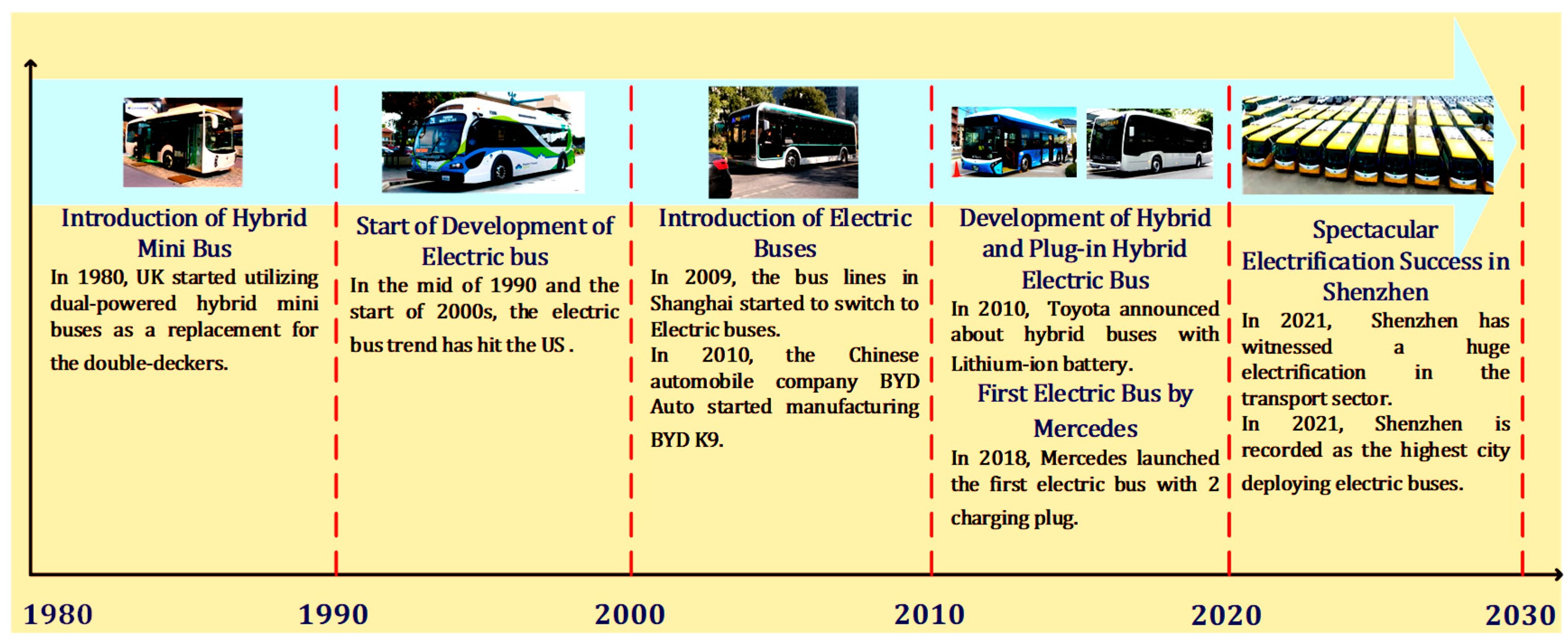
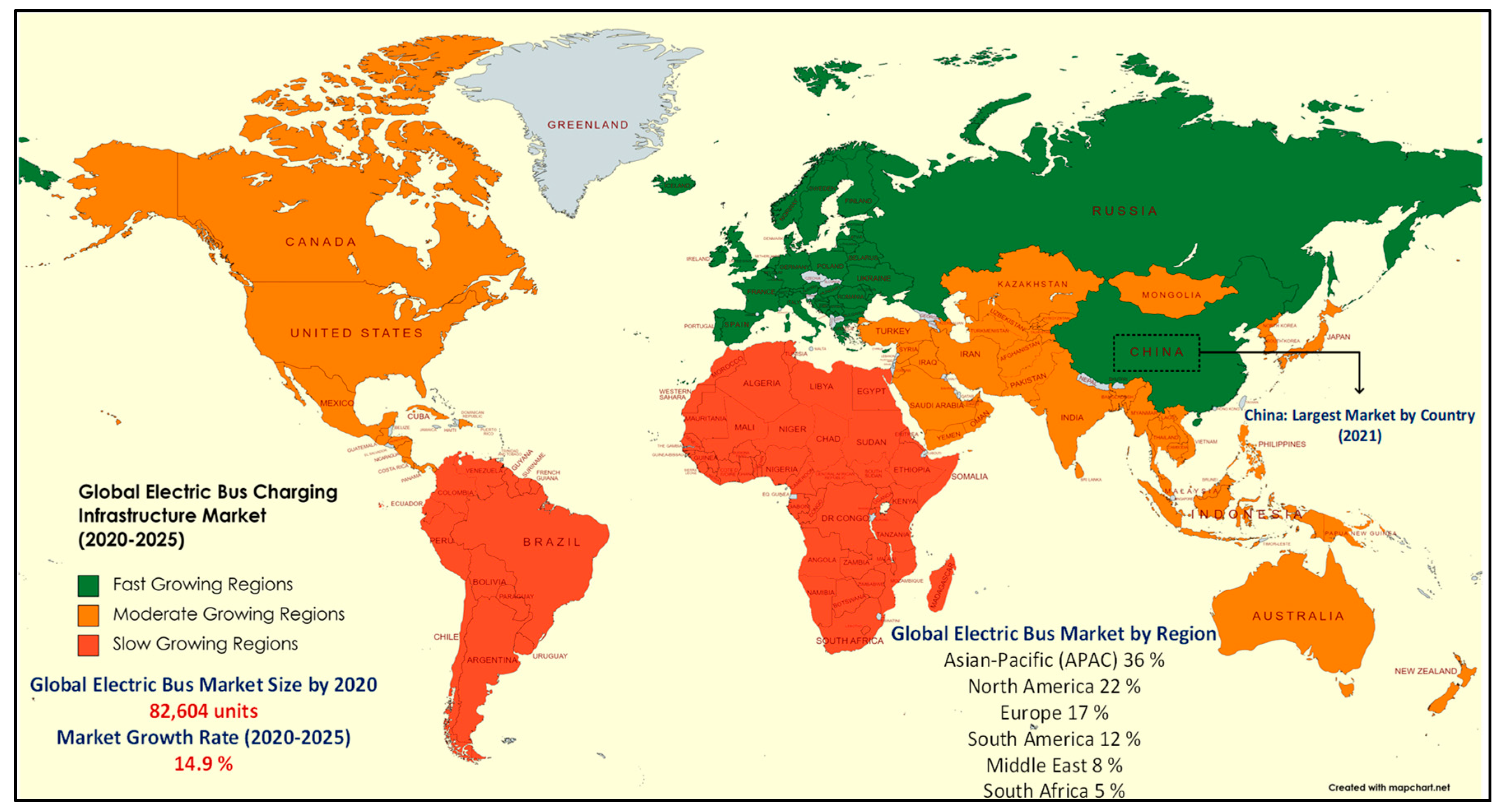

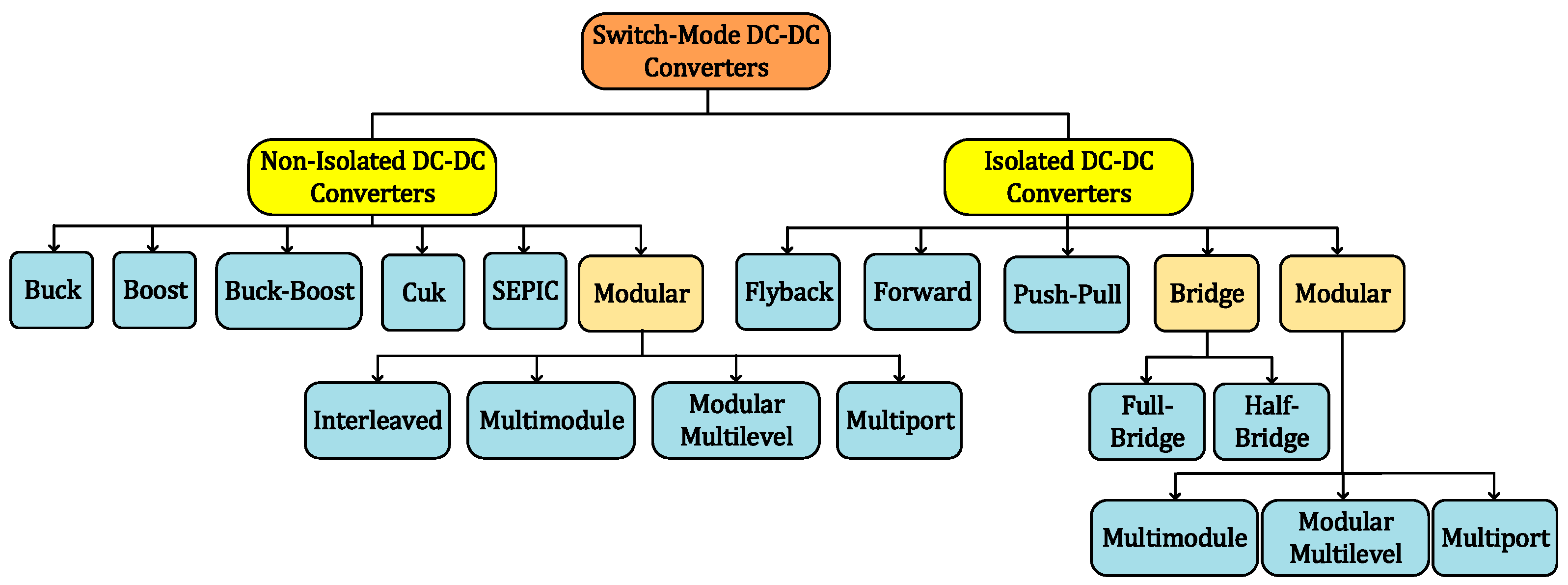

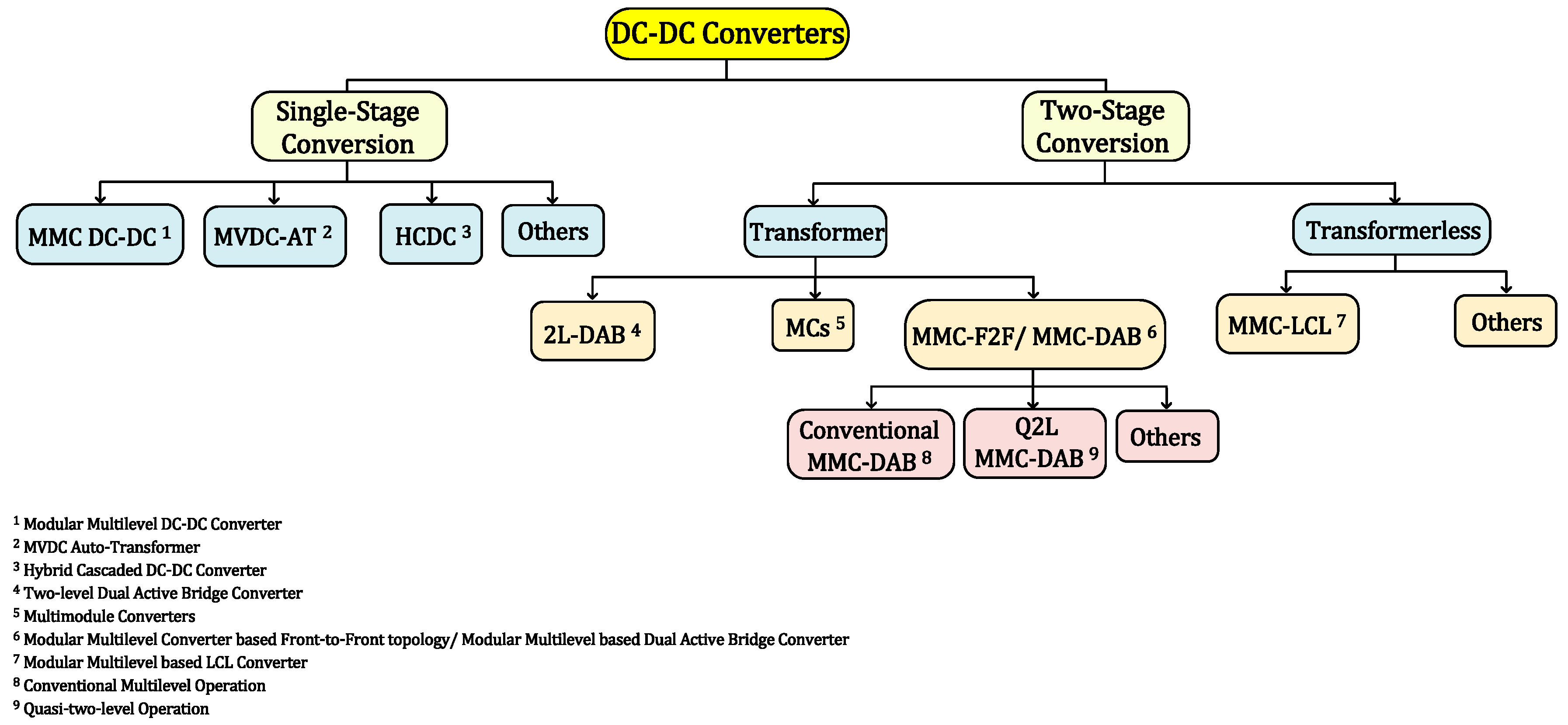
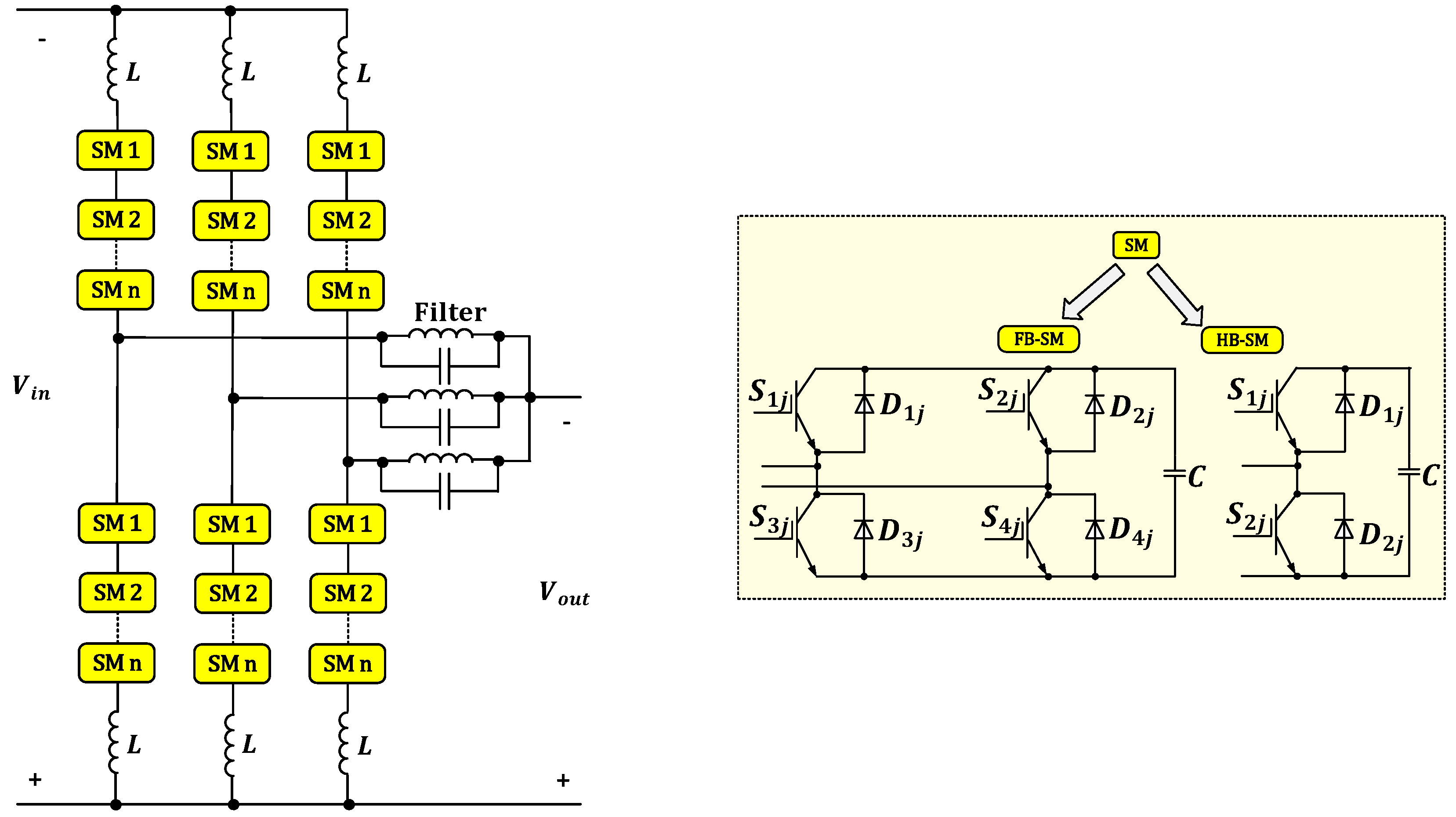

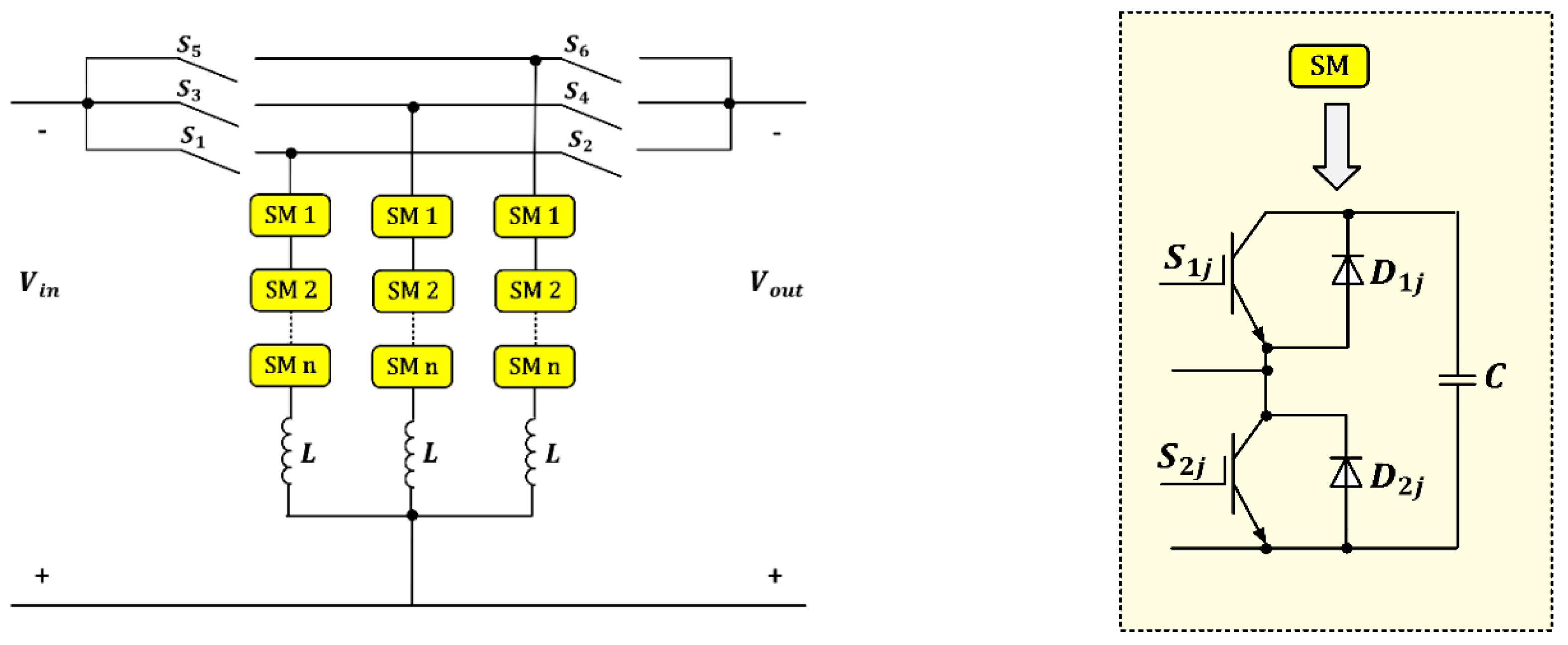



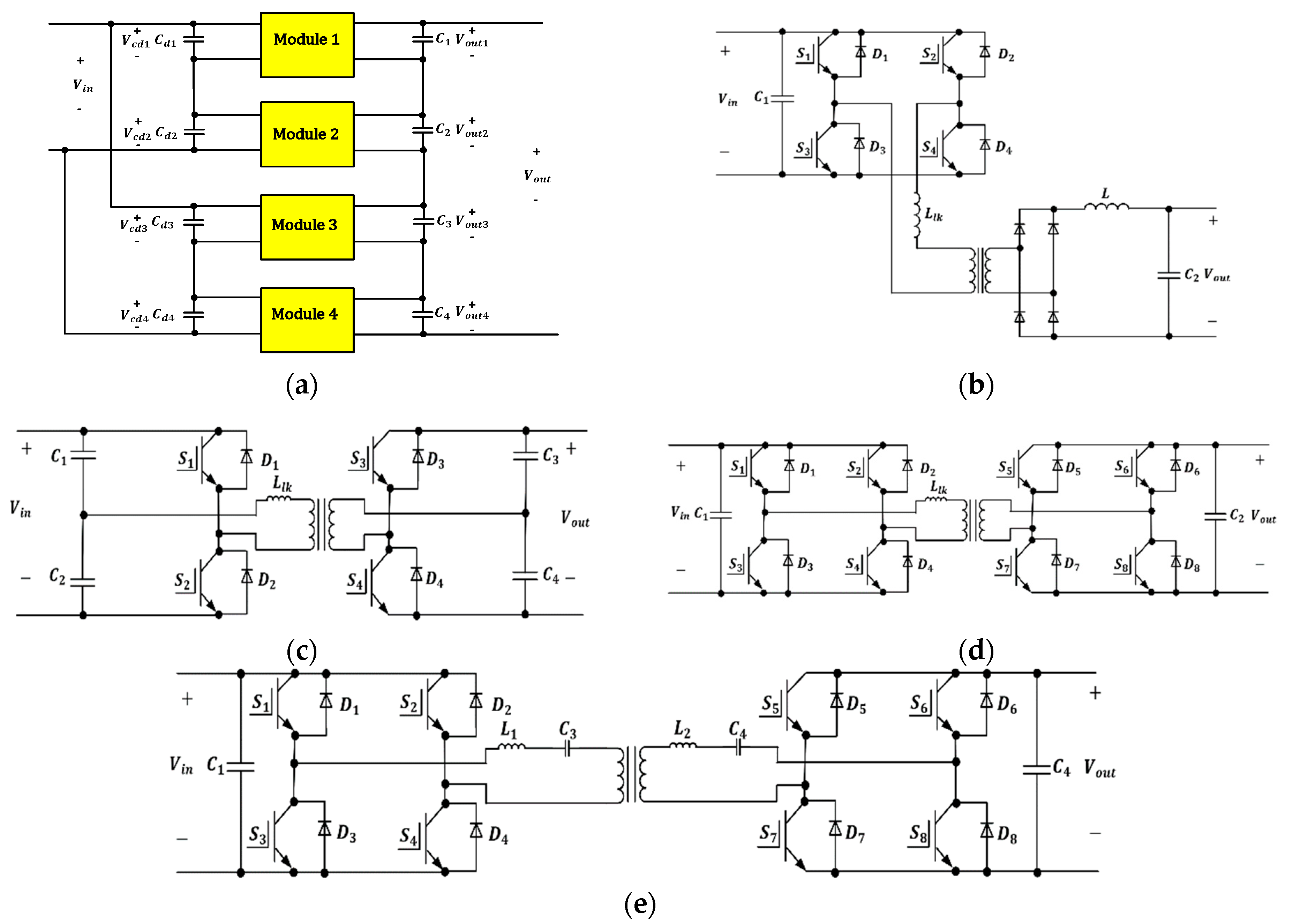

| Topology | Power Range | Transformer Utilization | Number of Active Switches | Cost |
|---|---|---|---|---|
| Flyback | Lowest Highest | Single-ended | 1 | Lowest Highest |
| Forward | Single-ended | 1 | ||
| Active Clamp Forward | Single-ended | 2 | ||
| Push-Pull | Double-ended | 2 | ||
| Half-Bridge | Double-ended | 2 | ||
| Full-Bridge | Double-ended | 4 |
| P.O.C | MMC | MVDC-AT | MMC-F2F/MMC-DAB | 2L-DAB/MC-DAB |
|---|---|---|---|---|
| Conversion Stages | Single | Single | Two | Two |
| Galvanic Isolation | × | × | ✓ | ✓ |
| Galvanic isolation is necessary | ||||
| Transformation Ratio | Low and medium | Low and medium | High | High |
| Semiconductor Efforts | Multilevel (Lower ), lower voltage stresses | Two-level Waveform | ||
| Switching Loses | ✓ | × | ||
| Lower switching losses compared to the two-level switching | ||||
| Switching frequency | Lower switching frequency (single transformer is used) | Higher switching frequency (multiple transformers are used) | ||
| Transformer size | × | ✓ | ||
| Larger in size compared to 2L-DAB and MC-DAB based | ||||
| Number of semiconductor devices | × | ✓ | ||
| Switches are higher than the MC-DAB DC-DC converter. | Lower number of switches | |||
| Efficiency | Poor efficiency (especially with high voltage transformation ratio) | Higher efficiency | ||
| Provide higher efficiency in low partial load conditions. | ||||
| Performance | Single-stage is superior when galvanic isolation is not required or transformer ratio is not high | Better performance at high voltage transformation ratios. | ||
| Insulation Requirements | Not required | Multiple transformers require high insulation | ||
| Magnetic Components | A higher number of capacitors (yet the effect on the total investment cost is low). | A lower number of capacitors. | ||
| Investment Costs | × | ✓ | ||
| The cost of MMCs is higher than the MC-DAB converters. | Lower investment cost. | |||
| Manufacturer | ✓ | × | ||
| MC-DAB is more complex in terms of manufacturing | ||||
Publisher’s Note: MDPI stays neutral with regard to jurisdictional claims in published maps and institutional affiliations. |
© 2022 by the authors. Licensee MDPI, Basel, Switzerland. This article is an open access article distributed under the terms and conditions of the Creative Commons Attribution (CC BY) license (https://creativecommons.org/licenses/by/4.0/).
Share and Cite
ElMenshawy, M.; Massoud, A. Medium-Voltage DC-DC Converter Topologies for Electric Bus Fast Charging Stations: State-of-the-Art Review. Energies 2022, 15, 5487. https://doi.org/10.3390/en15155487
ElMenshawy M, Massoud A. Medium-Voltage DC-DC Converter Topologies for Electric Bus Fast Charging Stations: State-of-the-Art Review. Energies. 2022; 15(15):5487. https://doi.org/10.3390/en15155487
Chicago/Turabian StyleElMenshawy, Mena, and Ahmed Massoud. 2022. "Medium-Voltage DC-DC Converter Topologies for Electric Bus Fast Charging Stations: State-of-the-Art Review" Energies 15, no. 15: 5487. https://doi.org/10.3390/en15155487
APA StyleElMenshawy, M., & Massoud, A. (2022). Medium-Voltage DC-DC Converter Topologies for Electric Bus Fast Charging Stations: State-of-the-Art Review. Energies, 15(15), 5487. https://doi.org/10.3390/en15155487







